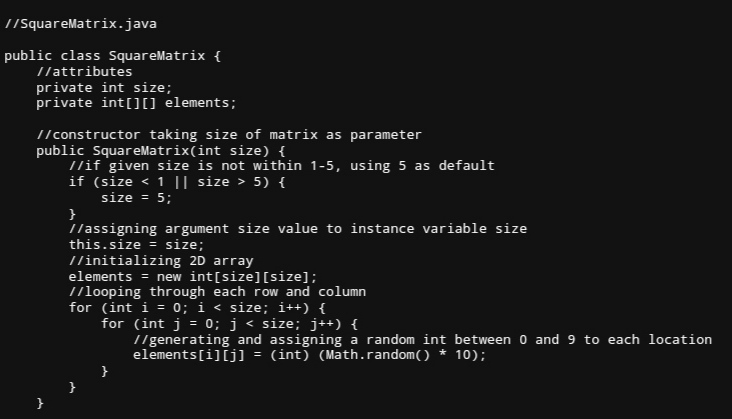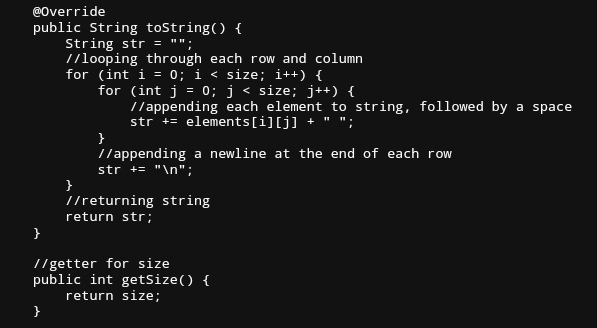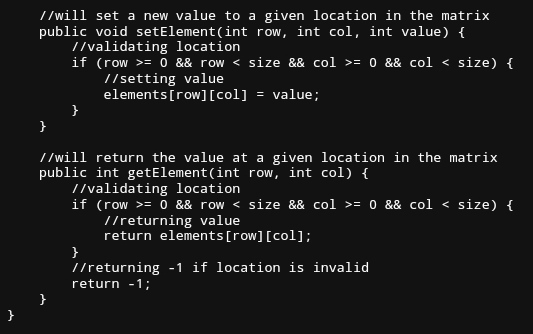
1. Create a java class named SquareMatrix with two instance variables: an integer named
size that contains the size of the matrix, and a two dimensional array named
elements that contains the elements of the matrix. Write the following methods:
• Constructor: takes an integer parameter for size, checks that it is a value
between 1 and 5 inclusive, and creates the two dimensional array elements
with size rows and size columns and initializes it with random values
between 0 and 9 inclusive. If the size parameter is out of range, size should
be initialized to 5
• String toString(): returns a string containing the elements of the matrix
properly formatted, with each row in a new line
• int getSize(): returns the size of the matrix
• void setElement(int row, int col, int value): checks if row and col define a
valid location and sets the corresponding element to value
• int getElement(row, col): checks if row and col define a valid location and
return the value of the corresponding element; if the location is invalid,
return -1
• Draw a UML diagram for your program. Scan it using a scanner app on
your phone, or take a clear picture. Save as pdf.
2. Write an java application called Driver which calls each method of the SquareMatrix class at
least once.
Notes:
1. You will have to code two separate files.
2. Add a comment on top of each method, describing what that method does.
file name is " SquareMatrix.java "



Trending nowThis is a popular solution!
Step by stepSolved in 4 steps with 6 images

- Create a class: “Question 1” with data members: 1D integer array of maximum size: 100, n(int). Create a dynamic constructor which takes input of n and n no. of array elements. Apartfrom taking input this class also displays the maximum and minimum elements from the givenarray elements.arrow_forwardwrite a code in javaarrow_forwardDefine a class called Book. This class should store attributes such as the title, ISBN number, author, edition, publisher, and year of publication. Provide get/set methods in this class to access these attributes. Define a class called Bookshelf, which contains the main method. This class should create a few book objects with distinct names and store them in an ArrayList. This class should then list the names of all books in the ArrayList. Enhance the program by providing a sort function, which will sort the books in ascending order of their year of publication. Create a few more Bookobjects with the same names but with different edition numbers, ISBNs, and years of publication. Add these new Book objects to the ArrayList, and display the book list sorted by book name; for duplicate books of the same name, sort the list by year of publication. (Hint: You will need to define a comparator class that takes two Book objects as parameters of the compareTo This method should do a two-step…arrow_forward
- 1. Declare an array to save 4 Dog objects. The Dog class is provided below. Look into the Dog class and find what attributes are needed for a dog object. Then initialize five dogs with the following information: Lily, 5 years old Jacob, 2 years old Sugar, 8 years old Bush, 3 years old 2. Print out every dog using a for loop (use either regular for loop or for-each loop, your choice). But you may find when you print out, the name and age are not displayed. Why? 3. Fix this problem by implementing the toString method in the Dog class. Dog Class: public class Dog { private String name; private int age; public Dog(String name, int age) { this.name = name; this.age = age; } public void setName(String name) { this.name = name; } }arrow_forwardJava code 8. Given an existing ArrayList named friendList, find the first index of a friend named Sasha and store it in a new variable named index. 9. Given that an ArrayList of Integers named numberList has already been created and several values have already been inserted, write the statement necessary to insert the value 25 at the end of the list. 10. Declare an integer array named evens and fill it with even numbers from 2 through 10 in one statement. 11. Given an existing array named pets, find the size of the array and store it in a new variable named numPets. 12. Given an existing ArrayList named contactList, find the number of contacts in the ArrayList and store it in the existing variable named numContacts.arrow_forwardJAVA Program Homework #1. Chapter 7. PC# 2. Payroll Class (page 488-489) Write a Payroll class that uses the following arrays as fields: * employeeId. An array of seven integers to hold employee identification numbers. The array should be initialized with the following numbers: 5658845 4520125 7895122 8777541 8451277 1302850 7580489 * hours. An array of seven integers to hold the number of hours worked by each employee * payRate. An array of seven doubles to hold each employee’s hourly pay rate * wages. An array of seven doubles to hold each employee’s gross wages The class should relate the data in each array through the subscripts. For example, the number in element 0 of the hours array should be the number of hours worked by the employee whose identification number is stored in element 0 of the employeeId array. That same employee’s pay rate should be stored in element 0 of the payRate array. The class should have a method that accepts an employee’s identification…arrow_forward
- JAVA PROGRAM Homework #1. Chapter 7. PC# 2. Payroll Class (page 488-489) Write a Payroll class that uses the following arrays as fields: * employeeId. An array of seven integers to hold employee identification numbers. The array should be initialized with the following numbers: 5658845 4520125 7895122 8777541 8451277 1302850 7580489 * hours. An array of seven integers to hold the number of hours worked by each employee * payRate. An array of seven doubles to hold each employee’s hourly pay rate * wages. An array of seven doubles to hold each employee’s gross wages The class should relate the data in each array through the subscripts. For example, the number in element 0 of the hours array should be the number of hours worked by the employee whose identification number is stored in element 0 of the employeeId array. That same employee’s pay rate should be stored in element 0 of the payRate array. The class should have a method that accepts an employee’s identification…arrow_forwardin java Integer numVals is read from input and integer array userCounts is declared with size numVals. Then, numVals integers are read from input and stored into userCounts. If the first element is less than the last element, then assign Boolean firstSmaller with true. Otherwise, assign firstSmaller with false. Ex: If the input is: 5 40 22 41 84 77 then the output is: First element is less than last element 1 2 3 4 5 6 7 8 9 10 11 12 13 14 15 16 17 18 19 20 import java.util.Scanner; public class UserTracker { publicstaticvoidmain(String[] args) { Scannerscnr=newScanner(System.in); intnumVals; int[] userCounts; inti; booleanfirstSmaller; numVals=scnr.nextInt(); userCounts=newint[numVals]; for (i=0; i<userCounts.length; ++i) { userCounts[i] =scnr.nextInt(); } /* Your code goes here */ if (firstSmaller) { System.out.println("First element is less than last element"); } else { System.out.println("First element is not less…arrow_forwardJAVA PROGRAM Homework #1. Chapter 7. PC# 2. Payroll Class (page 488-489) Write a Payroll class that uses the following arrays as fields: * employeeId. An array of seven integers to hold employee identification numbers. The array should be initialized with the following numbers: 5658845 4520125 7895122 8777541 8451277 1302850 7580489 * hours. An array of seven integers to hold the number of hours worked by each employee * payRate. An array of seven doubles to hold each employee’s hourly pay rate * wages. An array of seven doubles to hold each employee’s gross wages The class should relate the data in each array through the subscripts. For example, the number in element 0 of the hours array should be the number of hours worked by the employee whose identification number is stored in element 0 of the employeeId array. That same employee’s pay rate should be stored in element 0 of the payRate array. The class should have a method that accepts an employee’s identification…arrow_forward
- Create an array of objects of the Person class, of size 4. Create three objects of the Person class, with values, and assign the objects to the array. Loop through the array and print the name, job, and email of all Personobjects.arrow_forwardIn C# Use a one-dimensional array to solve the following problem. Write a class called ScoreFinder. This class receives a single dimensional integer array representing passer ratings for NFL players as an argument for its constructor. The test class will provides this argument. The test class then calls upon a method from the ScoreFinder class to start the process of finding a specific rating, which will be provided by the user. The method will iterate through the array and find any matching values. For all the matches that are found, the method will note the index of the cell along with its value. At completion, the method will print a list of all the indices and the associated scores along with a count of all the matching values.arrow_forwardJAVA PROGRAM Homework #1. Chapter 7. PC# 2. Payroll Class (page 488-489) Write a Payroll class that uses the following arrays as fields: * employeeId. An array of seven integers to hold employee identification numbers. The array should be initialized with the following numbers: 5658845 4520125 7895122 8777541 8451277 1302850 7580489 * hours. An array of seven integers to hold the number of hours worked by each employee * payRate. An array of seven doubles to hold each employee’s hourly pay rate * wages. An array of seven doubles to hold each employee’s gross wages The class should relate the data in each array through the subscripts. For example, the number in element 0 of the hours array should be the number of hours worked by the employee whose identification number is stored in element 0 of the employeeId array. That same employee’s pay rate should be stored in element 0 of the payRate array. The class should have a method that accepts an employee’s identification…arrow_forward
 Database System ConceptsComputer ScienceISBN:9780078022159Author:Abraham Silberschatz Professor, Henry F. Korth, S. SudarshanPublisher:McGraw-Hill Education
Database System ConceptsComputer ScienceISBN:9780078022159Author:Abraham Silberschatz Professor, Henry F. Korth, S. SudarshanPublisher:McGraw-Hill Education Starting Out with Python (4th Edition)Computer ScienceISBN:9780134444321Author:Tony GaddisPublisher:PEARSON
Starting Out with Python (4th Edition)Computer ScienceISBN:9780134444321Author:Tony GaddisPublisher:PEARSON Digital Fundamentals (11th Edition)Computer ScienceISBN:9780132737968Author:Thomas L. FloydPublisher:PEARSON
Digital Fundamentals (11th Edition)Computer ScienceISBN:9780132737968Author:Thomas L. FloydPublisher:PEARSON C How to Program (8th Edition)Computer ScienceISBN:9780133976892Author:Paul J. Deitel, Harvey DeitelPublisher:PEARSON
C How to Program (8th Edition)Computer ScienceISBN:9780133976892Author:Paul J. Deitel, Harvey DeitelPublisher:PEARSON Database Systems: Design, Implementation, & Manag...Computer ScienceISBN:9781337627900Author:Carlos Coronel, Steven MorrisPublisher:Cengage Learning
Database Systems: Design, Implementation, & Manag...Computer ScienceISBN:9781337627900Author:Carlos Coronel, Steven MorrisPublisher:Cengage Learning Programmable Logic ControllersComputer ScienceISBN:9780073373843Author:Frank D. PetruzellaPublisher:McGraw-Hill Education
Programmable Logic ControllersComputer ScienceISBN:9780073373843Author:Frank D. PetruzellaPublisher:McGraw-Hill Education





